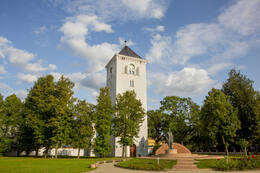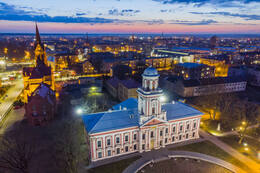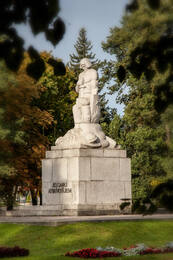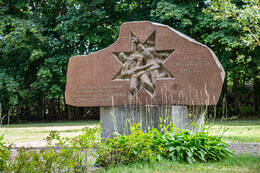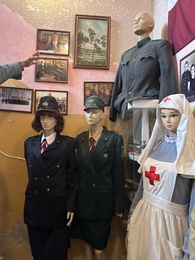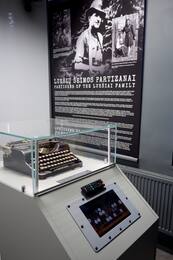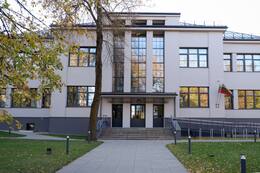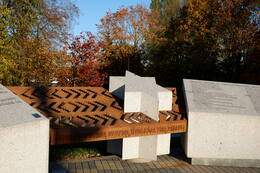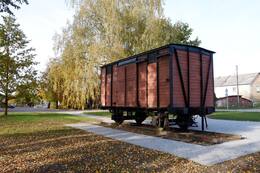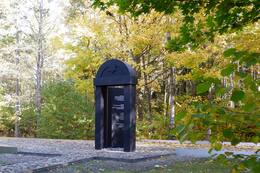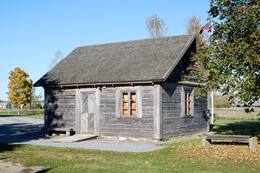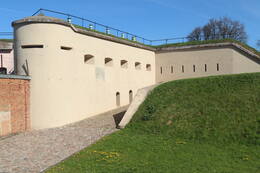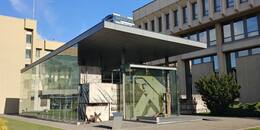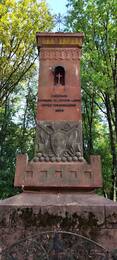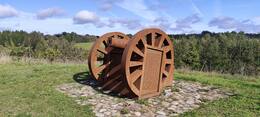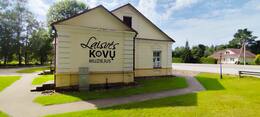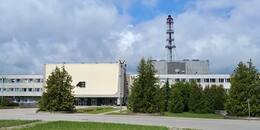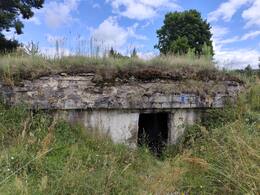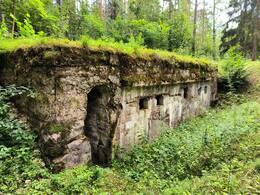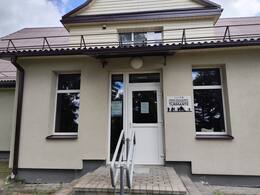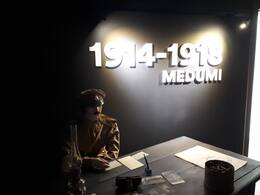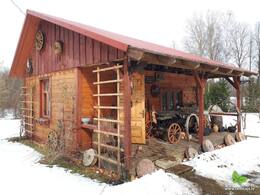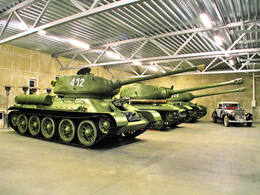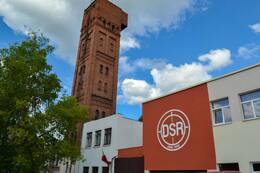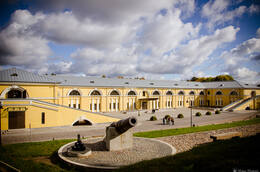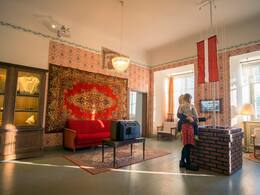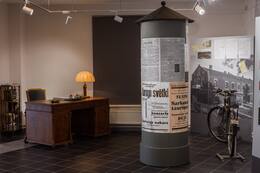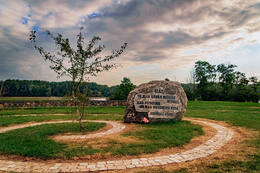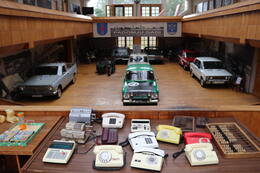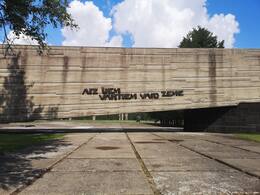The Great Cross-Border Route – Military Heritage of Latvia and Lithuania in 100 Years
The Tower of Jelgava Holy Trinity Church
The Tower of Jelgava Holy Trinity Church is located in the centre of the city of Jelgava. The history of the tower spans more than four centuries, becoming an important witness to the development of the city, as well as tragic events. The church was built in 1574 on the orders of the Duke of Courland and Semigallia, Gotthard Kettler, and its tower, completed in 1688 under the lead of the construction master Martin Knoch, became one of the most prominent structures of the city. During the Second World War, Jelgava was severely de stroyed and, in 1944, the church burnt down after a Soviet air raid. After the war, the Soviet authorities blew up the altar part of the church and demolished the walls. Only the tower was preserved as a strategic object, as it was the highest point in the city. During and after the war, the tower was used for military purposes. Enemy positions were observed and the surroundings were controlled from the tower. During the post-war years, the tower also served as a stra tegic point for resistance activities. It became a secret meeting place and a base for the transfer of information that was essential for the fight against the Soviet regime. The tower, while retaining its historical significance, has been reborn today as a cultural and educational centre.
Jelgava History and Art Museum of Ģ. Eliass
Jelgava History and Art Museum of Ģ. Eliass is located in a building that is called Academia Petrina (Peter’s Acad emy). It was built in 1775 as the first university in Latvia and is one of the few public buildings in Jelgava to survive and be restored after World War II. In the summer of 1944, Jelgava lost almost everything – a large part of its popu lation and historic buildings, which were hardly restored after World War II. The predecessor of the current museum – the Kurzeme Provincial Museum – was founded in 1818. It was the second oldest museum in Latvia and the first one established outside Riga. The museum has been housed in the Academia Petrina building since 1952. Today, the museum features permanent exhibitions on the renowned Latvian artist Ģederts Eliass (1887–1975), the prehistory and Middle Ages of the Zemgale region, Jelgava during the era of the Duchy of Courland and Semigallia (1561–1795), the Courland Governorate (1795–1918), and the period of Latvia’s independence (1918–1940). The museum exhibition “Life Continues Under Foreign Rule” explores life in Latvia during the German and Soviet oc cupations. The virtual exhibition “Wars and a Soldier Through the Ages of Jelgava” offers insight into the various wars that have affected Jelgava, including historical events from the First and Second World Wars.
Monument to the Liberators of Jelgava “Lāčplēsis”
The Monument to the Liberators of Jelgava “Lāčplēsis” is located in Jelgava, at Station Park, opposite the Railway Station building. It was opened on 22 June 1932, with the participation of the Pre sident of Latvia A. Kviesis, and was built to commemorate the liberation of Jelgava on 21 November 1919, during the Latvian War of Independence. In 1940, during the first period of Soviet occupation, the monument was not affected by changes. In 1941, when the Soviet occupiers were replaced by the German occupation forces, the head of the German occupation administration, von Medem, who had retur ned to Jelgava (his ancestors were the original builders of Jelgava Palace), did not like the unequivocal symbolism of the monument. On 31 October 1942, the German occupation authorities ordered the author of the monument, Kārlis Jansons, to remove the image of a German knight from the monument. In 1950, the Soviet occupation authorities gave the order for the monument to be destroyed. With the help of a tractor, Lāčplēsis was torn off its pedestal, smashed, and an attempt was made to destroy it in a stone crusher. However, Lāčplēsis proved to be so hard that the crusher broke. The unbroken middle part of the monument was secretly buried in the grounds of a kindergarten. In 1988, a fragment of the monument was found and is now lo cated in front of the Jelgava History and Art Museum of Ģederts Eliass. The monument was restored and inaugurated on 21 No vember 1992. It was created by sculptor Andrejs Jansons, who restored the monument created by his father, K. Jansons.
Monument to the Defenders of Jelgava
The Monument to the Defenders of Jelgava – the Daugavgrīva Home Guards who stopped the German Army from attacking Jelgava at the end of April 1915, was unveiled in 1991 next to Svēte School in Jelgava Municipal ity. At the beginning of May 1915, a large demonstration was held in Jelgava to commemorate this important event. The fact that the Latvian Home Guards managed to stop the German attack was used by Jānis Čakste and his as sociates to justify the idea of establishing Latvian Riflemen units during World War I.
The author of the monument is sculptor Alīna Veibaha (1923–2011)
War Museum in Eleja
The museum is located in the former railway station build ing of Eleja Village. The War Museum in Eleja was established by the associa tion “Zemgales strēlnieks” (Zemgale Rifleman).
The rep resentatives of the association are active in public edu cation, putting on exhibitions, displays and educational programmes. The exhibition of the museum is mainly dedicated to World War II. It displays uniforms, equipment, armaments, and photographs of the historical period. The museum offers the opportunity to take photos in military uniforms of dif ferent historical periods and armies. The small two-storey building houses several hundreds of exhibits of military her itage. In addition, there are exhibits related to the town and surroundings of Eleja, the history of the region and its notable persons.
Joniškis Museum of History and Culture
Joniškis Museum of History and Culture was established in the centre of Joniškis in 1989. It features exhibitions reflecting the historical and archaeological treasures, ethnic culture and sacred art heritage of the region. Based on the initiative of historian Darius Vičas. The museum has an exhibition dedicated to the partisans of the Joniškis region. In a separate room, you are introduced to the personalities of partisans – fighters for Lithuanian freedom – and their struggle against the Soviet occupation. The exhibition features an authentic Olympia typewriter that served the last partisans of the Joniškis region, Kostas LiuberskisŽvainys and Steponas Erstikis-Patašonas. It was used to print issues of the partisan periodical “Partizanų šūvių aidas” (Echo of Partisan Shots). The underground newspaper was published from 1952 to 1957 in the territory of the Juozapavičius homeland (on the outskirts of Akmene, Joniškis, Žagarė and Kuršėnai districts). It is the last periodical published by partisans. The typewriter has been modified for interactive access to information – by pressing its keys, visitors see photos and hear stories about the partisan resistance. The radio receiver in
Šiauliai History Museum
The Šiauliai History Museum is located on Aušros Avenue in central Šiauliai. After reconstruction, the museum opened its doors in 2022. It is housed in the historical Aušros Museum building, which was built in 1932 based on the design of a local architect, Vlad Bite. Originally it was a school building, while a part of the building was dedicated for the purposes of the museum in 1933. Today, the Šiauliai History Museum combines state-of-the-art technology with traditional exhibitions and a modern exhibition of museum funds. Here, visitors are introduced to the history of Šiauliai, from the earliest records about the area to the proclamation of the Republic of Lithuania in 1918.
Part of the exhibition is devoted to war themes. The first-floor hall features a restored short film that is based on historical documents about the Battle of the Sun that took place in the Šiauliai area; there are also exhibits (objects, documents, photos) related to World War I, which severely devastated the city, resulting in the loss of both inhabitants and infrastructure. The exhibition also displays evidence of the battles against the Bermontians, who invaded the town in 1919 and vandalised the houses. The content of the exhibitions of Šiauliai History Museum is expanded by knowledge rooms and an open-air exhibition. The museum also has an exhibition and event hall for multifunctional activities.
The Hill of Rebels
The Hill of Rebels is a sandy hill in western Šiauliai, where both World Wars left their marks.
The site became notorious in the second half of the 19th century when the members of the 1863–1864 uprising were buried on the hill and sentenced to death for fighting against the oppression by the Tsarist Russian Empire. The site gave rise to terrifying legends and was abandoned and rarely visited; finally, it became known as the Hill of Rebels. During the First World War, soldiers of the German Empire were buried here.
In 1926, work on landscaping the hill started. Karolis Reisonas, a city engineer, offered to design an obelisk for the monument dedicated to the rebels. In 1928, the 10th anniversary of the independence of Lithuania was celebrated and Rebel Garden was opened on the Hill of Rebels, however, the construction of the monument was not completed until 1935. The monument, a 14-metre-high pink granite obelisk, was unveiled and consecrated, and the remains of the rebels were reburied. During the Second World War, the soldiers of the Third Reich, who died in 1941–1944, were buried on the hill.
During the Soviet occupation, the gravestones were dismantled, but in 1955–1957, the obelisk of the Hill of Rebels was reconstructed – all national and religious symbols were removed from it. In 1988, to commemorate the 125th anniversary of the uprising, the authentic appearance of the monument was restored.
Square for the Righteous Among the Nations (Monument)
On 22 October 2021, the Square for the Righteous Among the Nations (monument) was inaugurated in Šiauliai, at the intersection of Ežero and Vilniaus streets. It is the first monument to the Righteous Among the Nations in Lithuania. The monument was created by the designer Adas Toleikis, a native of Šiauliai, and the idea of the monument was initiated by Sania Kerbelis, the chairman of the Jewish community of Šiauliai County.
The monument “Jungtis” is engraved with the surnames of the “Righteous Among the Nations” of Šiauliai County, thus commemorating 148 Jewish rescuers, while artistic accents mark the gates of the Šiauliai Ghetto. There were two ghettos in Šiauliai: in the so-called Kaukazo Quarter and in the Ežero-Trakų Street Quarter. Physically strong and able-bodied people were sent to the first one, and specialists (doctors, mechanics, etc.) to the second. The Šiauliai Ghetto was established in the summer of 1941 on the orders of the Šiauliai Commandant and liquidated in 1944 with the retreat of Nazi German troops. The remaining Jews were transferred to Stutthof and Dachau concentration camps. More than 5,950 Jews were imprisoned in the Ghettos. During the inter-war period, Šiauliai was home to about 6,500–8,000 Jews, some of whom left voluntarily into mainland Russia. After the Holocaust, there were only about 350–500 Jews left.
Deportation train wagon
A restored deportation train carriage is located near Radviliškis railway station as a reminder of the tragic history of the mass deportations of the inhabitants of the Republic of Lithuania
to remote areas of the Soviet Union by the Soviet occupation authorities from 1941–1952. More than 3,000 people were deported from Radviliškis alone.
In total, approximately 135,500 people were deported from Lithuania from 1941–1952. On 14 June 1941 – the first day of mass deportations in Lithuania – train carriages began to be “filled” with the inhabitants of Radviliškis and the surrounding area.
In 2012, the carriage was handed over to Radviliškis District Municipality by the Vytautas the Great Special Operations Jaeger Battalion of Lithuanian Armed Forces with the mediation of the Genocide and Resistance Research Centre of Lithuania. The authentic deportation train carriage was brought from Kaunas and carefully restored by the railwaymen, and now it houses a small exhibition.
The site of the First and Second Jewish Holocaust in Šeduva
The sites of the First and Second Jewish Holocaust in Šeduva are located in Liaudiškiai Forest (Radviliškis district), about 10 km south of Šeduva. A direction sign has been installed next to the gravel road.
The first Jewish burial site covers an area of 375 m² and is mostly paved and surrounded by forest. Approximately 400 people were murdered and buried there. The second burial site is located about 500 m away. The remains of Jews are buried in an area of 144 m². The site is flat and most of it is paved. Approximately 300 people were murdered and buried there.
In 1941, the entire Jewish community of Šeduva – almost 700 people – were murdered at these two sites. A month before their deaths, they were still held in the ghetto set up in the village of Pavartyčiai. On 25 and 26 August, the inhabitants of the ghetto were taken to Liaudiškiai Forest. The people were taken to a dug-out pit and killed by local policemen and hired help on the orders of the Germans. Among those killed were 230 men, 275 women and 159 children.
From 2014–2015, pursuant to the initiative of the Jewish Memorial Foundation of Šeduva, the sites of these murders were cleaned up and made accessible to visitors. Two statues by sculptor Romas Kvintas are erected at the sites of the mass killings: “The Door” and “Ray – Star”.
Sąjūdis Memorial to Lithuanian Freedom Fighters in Minaičiai (Minaičiai Bunker-Museum)
In the autumn of 1948, the farm of partisan supporters A. and S. Mikniai in the village of Minaičiai (Radviliškis district) was chosen as the wintering place for the Prisikėlimo Military District headquarters. The partisans dug a small bunker under the barn to house the staff of the district.
On 16 February 1949, the partisan commanders in Minaičiai finalised and published the declaration of the Lithuanian freedom struggle “Sąjūdis”. The main aim of the Declaration was to restore Lithuania to a parliamentary republic (as it was from 1920–1926). Eight people formally attended the meetings: Jonas Žemaitis- Vytautas, Juozas Šibaila-Merainis, Petras Bartkus-Žadgaila, Adolfas Ramanauskas-Vanagas, Aleksandras Gribinas-Faustas, Vytautas Gužas-Kardas, Leonardas Grigonis-Užpalis, and Bronius Liesys-Naktis.
The bunker was also used later. A partisan pharmacist Izabelė Vilimaitė-Stirna treated partisan Laurynas Mingilas-Džiugas, who was seriously wounded in the Battle of Užpelkiai. In 1953, the unoccupied bunker caved in and the owners earth-filled it.
In 2010, the work on the restoration of the partisan bunker and barn, as well as the construction of the monument began. The monument, created by sculptor Jonas Jagėla, bears the names of the partisans who signed the Declaration. An authentic, glassroofed partisan bunker has been built in the barn, and the visitors are provided an opportunity to see it from above; there is also an exhibition in the barn.
Kaunas Ninth Fort Museum
Kaunas Ninth Fort Museum is located at the crossroads of ma jor international transport routes near Kaunas and it is easily accessible by car. The Ninth Fort was built from 1903–1913 as one of the forts of the Kaunas fortress complex with the task of protecting the strategically important Linkuva ridge. The fort was built with the use of concrete slabs – an innovation of the time, elec tricity and ventilation system. The fort did not suffer damage during the First World War. From 1924 to 1940, the Ninth Fort was a prison for political prisoners and criminals, while from 1940 to 1941, it became an NKVD redistribution point. During the Second World War, the Ninth Fort became the site of a mass murder of Jews, where around 50,000 Jews from different countries were killed by the Nazi occupation regime. In 1958, a museum was established in the Ninth Fort to tell the story of Nazi crimes, and in 1984, a memorial complex was built and a monument to the victims of Nazism was erected (authors: Alfonsas Vincentas Ambraziūnas, Gediminas Baravykas and Vytautas Vielius). Today, the Ninth Fort Museum tells the story of the fortress, as well as the history of crimes committed by the Nazis and the Soviets.
Kaunas nuclear bunker
A museum has been created in the nuclear bunker of Kaunas, which is located 6 m below the ground, which gathers exhibits of private collectors (> 1200). The most interesting are the collection of gas masks and the largest exhibition of Cold War radio equipment and spying devices in the Baltic States.
January 13th Memorial of the Seimas of the Republic of Lithuania
The monument is located in Vilnius, in front of the Second Palace of the Parliament (Seimas) of the Republic of Lithuania. In January 1991, the people of Lithuania surrounded the Par liament Palace with barricades, in a fight for and in defence of their freedom. It was an attempt to protect Lithuania from military aggression by the Soviet Union of the time – Soviet at tempts to stage a coup d’état in Lithuania and restore Soviet rule. Barricades surrounded the Parliament building until the end of 1992. In 1993, in front of the Palace of the Seimas of the Republic of Lithuania, a unique memorial was erected – made of parts of the barricades and other relics – it was dedicated to the Lithuanian people who sacrificed their lives for freedom. On 13 January 1991, tragic events unfolded, as the Soviet Army and special forces occupied the Lithuanian Radio and Televi sion Centre building and the television tower, killing 14 freedom fighters and injuring around 600 people. As the tenth anniversary of the Defenders of Freedom Day was approaching, a decision was made to preserve the composition by creating a memorial to 13 January. The Memorial was inaugurated in 2008. The memorial preserves an authentic fragment of the 1991 par liamentary barricades and has a chapel with an icon to the Blessed Virgin Mary. The memorial displays objects brought by people and provides an insight into the events that took place during the defence of the independence of Lithuania.
Monument to the Soldiers Killed for Lithuania‘s Freedom in 1920
The monument is located in Giedraičiai.
On 19 June 1932, a monument dedicated to the fallen Lithuanian freedom fighters was unveiled in Giedraičiai. The construction of the monument was initiated by the inhabitants of Giedraičiai – the painter and author of the monument Antanas Jaroševičius, Pastor Meigis, Malvina Valeikienė and Matas Valeika, who sup ported the Lithuanian soldiers in battle, the community of Širvintos and the Lithuanian Army; the amount of 11,000 litas was raised for the construction of the monument. The appeal for donations for the monument states that it is being built “to honour victory and our eternal joy, which will remind us of the historical significance of the site and pay tribute to the soldiers buried in Giedraičiai”. The opening ceremony was sumptuous. It was attended by the President of the Republic of Lithuania, A. Smetona – Command er-in-Chief of the Lithuanian Armed Forces, representatives of the 2nd, 4th, 7th, and 9th Regiments and officers, who took part in the Battles of Giedraičiai. Flowers were dropped at the monument from military planes, and Malvina Valeikienė, a prominent Lithu anian personality and one of the organisers of the construction works of the monument, read out the names of the Lithuanian soldiers who died in Giedraičiai, and she was awarded the Order of the Cross of the Knight, 3rd Class. The flag of the local rifle men unit was consecrated at the monument. From 1962–1964, pursuant to the instructions of the Soviet administration, an un successful attempt was made to demolish the monument, but it was later declared a historical monument.
A stylised cannon commemorating the 100th anniversary of the Battle of Giedraičiai
A stylised cannon commemorating the 100th anniversary of the Battle of Giedraičiai is located behind the town of Giedraičiai, 200 m after turning off on road No. 172.
On 21 November 2020, a monument by sculptor Džiugas Jurkūnas was unveiled on a hill at the site of the Battle of Giedraičiai, commemorating the victory. The monument is a stylised interpretation of the battles of the Lithuanian Army against the Polish Army during the inter-war period. In an attempt to move away from the description of the conflict, the monument highlights the importance of the union of the two countries in the context of contemporary events. The rust-covered cannon symbolises the strong union of the re publics of Lithuania and Poland – two countries that fought each other a century before. The situation of the time is described on the sides of the monument; the Lithuanian and Polish Army units involved are mentioned and a brief description of the battle is provided. The Lithuanian Armed Forces are the initiator and the funder of the erection of the monument
Museum of the Battles for Freedom in Utena
The museum is located in Utena, near the junction of the Kaunas-Daugpilis (A6) and Vilnius-Utena (A14) trunk roads. The museum was established in 2015 at the former narrow gauge railway station building of Utena. The museum claims to be a form of poetry that tacitly exposes the post-war truth. The exhibition “A Common European Identity in the Context of Totalitarian Regimes” offers to explore the past of Lithuania and Europe through the history of one Lithuanian region. It tells the story of secret documents and the division of Europe in 1939, the Soviet occupation of Lithuania, the forced participation of Lithuanians in World War II, exile, post-war resistance and the organisation of collective farms in the Utena region. The painful events of 1940–1965 in the Utena region and the events in Lithuania are contrasted with life behind the Iron Curtain. The history of the narrow-gauge railway station also has tragic pages. From here, in 1941 and from 1945–1953, train cars with deportees were sent to Siberia.
Ignalina Nuclear Power Plant
Ignalina Nuclear Power Plant is located at a distance of 6 km from Visaginas, on the Visaginas-Ignalina road (KK177).
It is the only former nuclear power plant in the Baltic states. It is sometimes called the “sister” of Chernobyl because both plants have Soviet-made RBMK reactors. The first reactor (power block) of the Ignalina Power Plant was commissioned in 1983. It was planned to install four such reactors. After the installation of all the units, Ignalina was to become the most powerful nuclear power plant in the world.
The second reactor was due to be commissioned in 1986, but the Chernobyl accident postponed the start-up. However, in 1987, it was put into operation. In 1988, based on the initiative of the Lithuanian reform movement Sąjūdis, the “Ring of Life” campaign was organised in front of the power plant against the construction of Unit 3. The construction of the plant was conserved, and it was finally stopped in 1989. After the accident at Chernobyl, the safety system of RBMK-type reactors was upgraded but their proliferation was stopped.
Ignalina Nuclear Power Plant is listed in the Guinness Book of World Records. It became famous again in 2019 as the location for the production of HBO and Sky UK TV miniseries Chernobyl. Decommissioning works of the nuclear power plant started in 2010. Nowadays, tours of the plant are organised and an exhibition hall has been set up.
Blindages of the German Army Support Point in Tilžė Village
The blindages are located in the village of Tilžė, just next to road No. 5303.
Two blindages of the 88th Division of the German 8th Army, which fought against the Russian Army on this front from 1915–1918, were designed to protect the soldiers from enemy fire. They were made of concrete. A small amount of reinforcement is visible in the roof structure of the shelter. The inscriptions “88 J.D.T.” preserved on the beams of the blindages (metal gutters) indicate that they were made by units of the 88th Division.
WWI German Army Blindage (Command Post)
The WWI German Army Blindage (command post) is located in the village of Kimbartiškė, next to road No. 5303.
From 1915–1918, the 88th Division of the German 8th Army fought against the Russian Army on this section of the front. A blindage (command post) was situated here. It was built from the most durable building materials – concrete and rebar – and has two entrances with a small row of windows between them. The blindage had electricity, and water was taken from a nearby well; there were two stoves, wooden benches and a sleeping ledge. The premises for the officers, communications offices and redressing rooms had white walls.
This massive building is built to take advantage of the rugged terrain; therefore, it is installed in a small depression. It is an example of a passive fortification structure. Passive structures were not designed for active defence. They were designed to protect soldiers and ammunition from devastating artillery fire. Inside the structure, there are traces of whitewash on the walls. The site is identified as a former command post.
World War I Exposition in Turmantas
The exposition is located in Turmantas of Zarasai district.
During World War I, Turmantas was an important logistical point for the German 88th Division on the Eastern Front. The World War I exposition in Turmantas is part of the international route “Along the Trails of the First World War” and is located in the primary school building of the town. The modern and virtualreality- enhanced exposition features many unique artefacts, replicas and photographs of World War I, as well as introduces the combat conditions and lives of soldiers on the Eastern Front, their weapons and ammunition, as well as uniforms and equipment.
First World War Museum
The fiercest battles of the First World War in Latvia took place near Daugavpils in August and October 1915, in the highlands of Ilūkste and Medumi. The Germans tried to break through to Daugavpils, but the Russians – to push them back. Both sides were unsuccessful and began to build trenches, creating in depth defence positions consisting of three lines. The First World War Museum in Medumi is dedicated to these battles. The first part of the exhibition presents the history of the vicinity of Medumi, providing testimonies that bear evi dence that Medumi was a well-populated and developed area before the war. Part 2 focuses on the events of the First World War in Europe and Latvia.
Here, you can learn about the lives of soldiers and the innovations that emerged during the war, as well as examine the weapons used by the German and Russian armies. In the third hall of the exhibition, visitors can put themselves in the shoes of a soldier by experiencing bunker life. In this hall, a replica of a Russian bunker has been created – a fragment of a trench with a small shelter, elements of a battlefield and dummies of soldiers. Since the wooden bunkers of the Russian Army did not survive, they have been reconstructed at the museum, while the concrete bunkers of the German Army can be seen by visiting the International route of WWI Bunkers. The hall, with the imitation of a shelter, audio and video equipment, creates an authentic atmos phere of the battlefield.
First World War local history collection in Medumos
It is located in the village of Medumu, Jaunatnes Street 4.
A private collection of historical evidence created by the Stikanis family. A collection of artifacts from the First and Second World War has been created, collected mostly from Medumu Parish and the surrounding area. Both military heritage items and household items, coins, photographs can be viewed.
The private collection can be viewed by contacting us in advance. Entry for donations.
The Museum of Military Vehicles in Svente
The museum is located next to the hotel “Sventes Muiža” (Svente Manor). The exhibition of the museum is unique since the objects in the collection were found on former battlefields. Soviet military equipment has been skilfully restored – some exhib its can even be started up and used for demonstrations. The tanks on display are believed to be rare exhibits on a European scale. The museum displays:
• Soviet tanks – the T-34 medium tank and the IS-2 and IS-2M heavy tanks, which are named after Stalin;
• BRDM-2 and BRDM-1 armoured airborne reconnais sance vehicles;
• military vehicles Jeep Willys and GAZ-67;
• self-propelled guns;
• cannons and other pieces of equipment
Daugavpils Lead Shot Factory
The Daugavpils Lead Shot Factory, founded in 1885, is the oldest ammunition factory in Northern Europe, the only factory of its kind in the Baltic states, and one of the oldest industrial heritage sites in Latvia. It is home to Europe’s only operational lead shot tower. Over the centuries, the factory has been producing high quality hunting shots and continues to do so today. The factory preserves equipment and structures from the 19th century, which have been supplemented before and after the World Wars.
Modern equipment is used to produce ammunition. Visitors can see the historical exhibition and the shot casting workshop, as well as climb the unique 31.5-metre-high tower of the plant, beneath which a 13.5-metre-deep cooling well is situated. This factory is a popular tourist destination that attracts both local and foreign visitors, enabling them to discover the industrial heritage of the 19th century and see the old machinery in action. After the factory tour, visitors can test the products made at the shooting range of the factory.
Daugavpils Fortress
Daugavpils Fortress is an architectural, cultural and histori cal heritage monument of national importance. It is the last bastion-type fortress built in the world and the only surviving example of a fortress from the first half of the 19th century in Central Europe, which has been preserved without significant changes. Its construction began in 1810, as Tsarist Russia prepared for Napoleonic invasion, and continued until 1878. In 1812, Russian and French troops fought at the unfinished fortress. After the Napoleonic Wars, the construction of the fortress continued, however, already during its construction, it began to lose its military importance. During World War I (1915–1918), the fortress served as a support and logistics base for the Russian Army. In February 1918, it was occupied by German troops, and in December – by Bolshevik forces.
In January 1920, the fortress was recaptured by Polish troops, who helped the Latvian Army to liberate Latgale from the Bolsheviks. From 1920 to 1940, the 4th Zemgale Division of the Latvian Army was stationed in the fortress. After the occupation of Latvia in 1940, Red Army units were stationed at the fortress, and during the German occupation, it became the site of the prisoner-of-war camp for Red Army POWs “Stalags-340”. After the second Soviet occupation in 1944, Soviet troops were again stationed in the fortress. Latvia regained the fortress in 1993 after the Russian Army had left.
Jersika National Partisan Hiking Route
A hard-to-find natural object. Hike length: approximately 22 km, can be completed in approximately 6 hours.
Hike length: approximately 22 km, can be completed in 6 hours.
Difficulty level: medium fitness hike.
Starting point: Jersika Elementary School (can be reached by train, bus).
End point: Vanagu Church (public transport does not run on weekends).
Note: The route includes a swimming break (during the summer season), fishing opportunities, a picnic area, and one public toilet. The route is also suitable for school-age children who already have experience in hiking of this length.
Go on a hike from Jersika to Vanagi, allowing yourself to be challenged in endurance, as the hike leads through forests, swamps, moors, meadows and country paths, and in the historical knowledge of the most prominent figures of the national partisan movement, their activities, see the most significant places about which local legends and written memories of fellow citizens are told. The path begins at the Jersika elementary school and leads to a memorial stone under an old oak tree, further along the way including the Jersika railway station. The inscription on the stone reads “LTS(p)A – For the fighters of the Latvian Fatherland Partisan Association. LTS(p)A united the national partisans of six Latvian districts in the fight against the communist occupation regime in 1945-1955”.
The walk continues along the railway tracks and winds along Lake Jersika, where the forest presents natural treasures: spring-flowering primroses and common sedge. The smell of primroses indicates that you are approaching the bog, but in spring it is especially surprising to see them blooming. A lazy walk is not possible, several ditches must be overcome, crossing the bog provides a tempering - water remains in the moss at every step, cranberry berries shine in the bushes. The bog is replaced by a forest and evidence of the former settlement of these places in homesteads - stately oaks, ruins of buildings, the site of a national partisan bunker surrounded by young growth. The path continues to the place mentioned in the testimonies as the place of founding of the Fatherland Guards (partisans) association. The forest massif also hides the memorial site “Avotnīca” (“Olūtneica”), where a campfire has been set up. The diversity of the forest is surprising, as is the width of the ditches. The destination of the hike is Vanagi Church, where priest A. Juhņevičs served, and about whom the film “Segvārds Vientulis” (directed by N. Pucis) tells the story.
Exhibition "Struggles for freedom in the 20th century" in Jēkabpils History Museum
Located in Krustpils Palace
Viewable exhibition "Fights for freedom in the 20th century"
Soviet repression. Hard memories. Sitting here in a club chair, you can listen to fragments of the book "Those were the times" by Ilmars Knaģ from Jēkabpils. On one of the walls of the room, a list of townspeople deported to Siberia slides dispassionately, like the credits after a movie. There you can watch an amateur video about the removal of the Lenin monument in Jēkabpils on the old TV. Visitors are interested not only in the content, but also in the technical possibilities - how did this film get on the old TV.
It is possible to listen to the lectures prepared by the museum specialists at the Jēkabpils History Museum or apply for an excursion: Jēkabpils and its surroundings in the First World War, Jēkabpils in 1990, the time of the Barricades, the deportations of 1949 - 70, Jēkabpilians Cavaliers of the Lāčplēš Military Order, etc.
The average duration of lectures is 40 min. Information and registration for lectures by calling 65221042, 27008136.
Jēkabpils History Museum is located in Krustpils Castle. In 1940, after the inclusion of Latvia in the USSR, the 126th Rifle Division was stationed in Krustpils Castle. During the Second World War, the castle housed a German infirmary, and after August 1944, a Red Army war hospital. After the war, Krustpils Castle with the adjacent manor buildings were occupied by the central warehouses of the 16th Long-range Reconnaissance Aviation Regiment and the 15th Air Army of the Soviet Army.
Exposition "Latvian Army in Pļaviņas in the 20th Century"
Located at Odzienas Street 2, Pļaviņas.
The permanent exposition "Latvian Army in Pļaviņas in the 20th Century" can be seen.
The building in Pļaviņas, Odzienas Street 2, has a long history - from the time when Stukmaņi wholesaler Hugo Apeltofts started active economic activity in it, thus promoting the development of Pļaviņas city, until the headquarters of the Latvian Eastern Front was established here during the War of Independence. In 1919, the activities of Latvian army units against the Red Army in Latgale were commanded directly from Pļaviņas.
In 1934, a memorial plaque was unveiled near this house with the inscription: "In 1919, the headquarters of the Eastern Front was located in this house, and here General Jānis Balodis took over the command of the Latvian National Army." It was removed and destroyed by the Soviets in 1940, but on June 16, 1990, with the support of the LNNK Plavinas branch, it was restored.
Now, next to the former headquarters building, there is a memorial stall dedicated to 15 cavalry of the Lāčplēsis Military Order born in Pļaviņas region. In Pļaviņas, as well as provides an insight into the life stories of the Knights of the Lāčplēsis War Order.
Not far from the exposition building is the Latgale Division headquarters building, which was built in 1913 by Count Teodors Medems as a Stukmaņi liqueur factory. In 1919 it was taken over by the regime of P. Stučka, where it had also established a prison. After the expulsion of the Bolsheviks, in 1925 the building was taken over by the Latvian Army, which housed the headquarters of the Latgale Division. 10 generals and other officers of the Latvian Army spent their military careers in this building. In 1940, the building was taken over by the Red Army. In the post-war years, it housed a school as well as a municipality. Around 1970, the building was started to be used by the production association "Rīgas Apīrsbs".
Visits to the exhibition must be booked in advance by calling T. 28442692.
A memorial dedicated to the mothers of Siberia in the "Garden of Destiny"
The Garden of Destiny is located on an island of the River Daugava, near the ruins of Koknese Castle. It is designed as a landscape architectural ensemble and is dedicated to the memory of the Latvian people that Latvia lost in the 20th century – those who fell in wars, were repressed, were forced into exile or otherwise suffered due to their political opinions. Like the Freedom Monument in Riga, the Garden of Destiny was created thanks to donations. In cooperation with the Latvian Association of Politically Repressed Persons, a memorial ensemble for women de ported to Siberia – mothers of Siberian children – has been created in the centre of the virtual House of Silence. Two boulders engraved with the words “Mother, you gave me life twice. When I was born and when I did not starve to death. A child of Siberia.” remind one of the selflessness and great sacrifice of mothers. World War I trenches have been preserved on the grounds of the Garden of Destiny. A memorial to the Latvian Riflemen has been created there, which was inaugurated on the 100th anniversary of the founding of the Riflemen Regiments. The composition of the site consists of two parts: The group of Latvian boulders symbolises those who stayed at home, while the row of boulders in the trenches of the First World War symbolises the Latvian Riflemen. The boulders were se lected and artistically arranged by sculptor Ojārs Feldbergs.
“Soviet Years” Exhibition at Aizkraukle Museum of History and Art
In November 2018, to celebrate the centenary of Latvia, the “Soviet Years” exhibition was opened at Aizkraukle Mu seum of History and Art – the largest exhibition in the Baltic states dedicated to the cultural and historical heritage of the 1950s–1980s. The exhibition is spread over three floors in an area of 1,060 m2. It reflects Soviet life in its multiple facets: everyday life, work and leisure, education and culture. Soviet-era cars are on display on the ground floor. A separate library – the Red Corner has been set up. A wide-ranging exhibition invites visitors to explore everyday life and apartment interiors during the Soviet era – furniture and household items, tableware, textiles and electrical appliances. Other exhibition spaces are dedicated to emigration, So viet repressions, everyday life, medicine, state structures, tourism and sport, childhood and education. Soviet military paraphernalia and uniforms are also on display among various exhibits.
Salaspils Memorial Ensemble
Salaspils Memorial and historical exhibit is located in Salaspils municipality, 1.2 km from the Riga-Daugavpils A6 highway. The Salaspils Memorial was unveiled in 1967 on the site where during World War II the Salaspils Camp was once located. It is a place that was used for Soviet propaganda and is shrouded in myths and half-truths. It is a good representation of the Nazi crimes and Communist ideology that was carried out during each of the occupations. This repressive camp was a part of the German penitentiary system. It had similarities with concentration camps, but it was not the same thing. It was created so that there would not be a disproportionate number of prisoners in Riga prisons. This camp was an “extension of the police prison”. And a variety of people were imprisoned here – Jews, the Red Army prisoners of war, absentees, political prisoners, criminals, prostitutes, members of the Latvian resistance movement, Baltic soldiers in the German Army or police, and others. The camp could hold up to 2,200 prisoners. The main cause of death (~2000) was malnutrition, working conditions, corporal punishment and illness.




